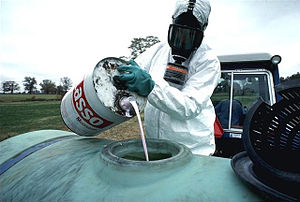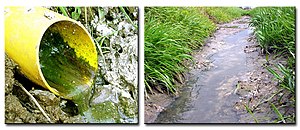
Back الأثر البيئي لمبيدات الآفات Arabic Impacto ambiental de los plaguicidas Spanish پیامد زیستمحیطی آفتکشها Persian Effets des pesticides sur l'environnement French השפעת חומרי הדברה על הסביבה HE Dampak lingkungan dari pestisida ID Kesan racun serangga terhadap alam sekitar Malay Impacto ambiental dos pesticidas Portuguese කෘමිනාශක මඟින් පරිසරයට සිදු කරන බලපෑම Singhalese Učinki pesticidov na okolje Slovenian

The environmental effects of pesticides describe the broad series of consequences of using pesticides. The unintended consequences of pesticides is one of the main drivers of the negative impact of modern industrial agriculture on the environment. Pesticides, because they are toxic chemicals meant to kill pest species, can affect non-target species, such as plants, animals and humans. Over 98% of sprayed insecticides and 95% of herbicides reach a destination other than their target species, because they are sprayed or spread across entire agricultural fields.[1] Other agrochemicals, such as fertilizers, can also have negative effects on the environment.
The negative effects of pesticides are not just in the area of application. Runoff and pesticide drift can carry pesticides into distant aquatic environments or other fields, grazing areas, human settlements and undeveloped areas. Other problems emerge from poor production, transport, storage and disposal practices.[2] Over time, repeat application of pesticides increases pest resistance, while its effects on other species can facilitate the pest's resurgence.[3] Alternatives to heavy use of pesticides, such as integrated pest management, and sustainable agriculture techniques such as polyculture mitigate these consequences, without the harmful toxic chemical application.
Environmental modelling indicates that globally over 60% of global agricultural land (~24.5 million km²) is "at risk of pesticide pollution by more than one active ingredient", and that over 30% is at "high risk" of which a third are in high-biodiversity regions.[4][5] Each pesticide or pesticide class comes with a specific set of environmental concerns. Such undesirable effects have led many pesticides to be banned, while regulations have limited and/or reduced the use of others. The global spread of pesticide use, including the use of older/obsolete pesticides that have been banned in some jurisdictions, has increased overall.[6][7]
- ^ George Tyler Miller (1 January 2004). Sustaining the Earth: An Integrated Approach. Thomson/Brooks/Cole. pp. 211–216. ISBN 978-0-534-40088-0.
- ^ Tashkent (1998), Part 75. Conditions and provisions for developing a national strategy for biodiversity conservation Archived 13 October 2007 at the Wayback Machine. Biodiversity Conservation National Strategy and Action Plan of Republic of Uzbekistan. Prepared by the National Biodiversity Strategy Project Steering Committee with the Financial Assistance of The Global Environmental Facility (GEF) and Technical Assistance of United Nations Development Programme (UNDP). Retrieved on 17 September 2007.
- ^ Damalas, C. A.; Eleftherohorinos, I. G. (2011). "Pesticide Exposure, Safety Issues, and Risk Assessment Indicators". International Journal of Environmental Research and Public Health. 8 (12): 1402–19. doi:10.3390/ijerph8051402. PMC 3108117. PMID 21655127.
- ^ "A third of global farmland at 'high' pesticide pollution risk". phys.org. Retrieved 22 April 2021.
- ^ Tang, Fiona H. M.; Lenzen, Manfred; McBratney, Alexander; Maggi, Federico (April 2021). "Risk of pesticide pollution at the global scale". Nature Geoscience. 14 (4): 206–210. Bibcode:2021NatGe..14..206T. doi:10.1038/s41561-021-00712-5. ISSN 1752-0908.
- ^ Lamberth, C.; Jeanmart, S.; Luksch, T.; Plant, A. (2013). "Current Challenges and Trends in the Discovery of Agrochemicals". Science. 341 (6147): 742–6. Bibcode:2013Sci...341..742L. doi:10.1126/science.1237227. PMID 23950530. S2CID 206548681.
- ^ Tosi, S.; Costa, C.; Vesco, U.; Quaglia, G.; Guido, G. (2018). "A survey of honey bee-collected pollen reveals widespread contamination by agricultural pesticides". The Science of the Total Environment. 615: 208–218. doi:10.1016/j.scitotenv.2017.09.226. PMID 28968582. S2CID 19956612.
© MMXXIII Rich X Search. We shall prevail. All rights reserved. Rich X Search

